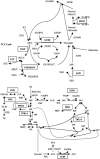Uncovering transcriptional regulation of metabolism by using metabolic network topology
- PMID: 15710883
- PMCID: PMC549453
- DOI: 10.1073/pnas.0406811102
Uncovering transcriptional regulation of metabolism by using metabolic network topology
Abstract
Cellular response to genetic and environmental perturbations is often reflected and/or mediated through changes in the metabolism, because the latter plays a key role in providing Gibbs free energy and precursors for biosynthesis. Such metabolic changes are often exerted through transcriptional changes induced by complex regulatory mechanisms coordinating the activity of different metabolic pathways. It is difficult to map such global transcriptional responses by using traditional methods, because many genes in the metabolic network have relatively small changes at their transcription level. We therefore developed an algorithm that is based on hypothesis-driven data analysis to uncover the transcriptional regulatory architecture of metabolic networks. By using information on the metabolic network topology from genome-scale metabolic reconstruction, we show that it is possible to reveal patterns in the metabolic network that follow a common transcriptional response. Thus, the algorithm enables identification of so-called reporter metabolites (metabolites around which the most significant transcriptional changes occur) and a set of connected genes with significant and coordinated response to genetic or environmental perturbations. We find that cells respond to perturbations by changing the expression pattern of several genes involved in the specific part(s) of the metabolism in which a perturbation is introduced. These changes then are propagated through the metabolic network because of the highly connected nature of metabolism.
Figures


References
-
- Peltonen, L. & McKusick, V. A. (2001) Science 291, 1224–1229. - PubMed
-
- Patil, K. R., Akesson, M. & Nielsen, J. (2004) Curr. Opin. Biotechnol. 15, 64–69. - PubMed
-
- Nielsen, J. & Olsson, L. (2002) FEMS Yeast Res. 2, 175–181. - PubMed
-
- Ihmels, J., Levy, R. & Barkai, N. (2004) Nat. Biotechnol. 22, 86–92. - PubMed
-
- DeRisi, J. L., Iyer, V. R. & Brown, P. O. (1997) Science 278, 680–686. - PubMed
MeSH terms
Substances
LinkOut - more resources
Full Text Sources
Other Literature Sources
Molecular Biology Databases

